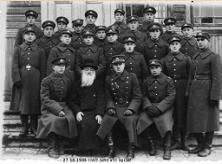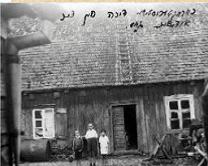What about the girls from Vilkaviskis ?
They were with us for the entire three years. At first they hid in a place that was covered with straw - the place was searched but they where not found. After that we built a window from glass so they could see if anyone approached and thus could escape via a tunnel. My mother was so happy that the three girls survived although they were very weak - they were not allowed to go outside.
Sperlingaite was very strong but the others were very weak we were afraid that they would go outside and give themselves up and us as well.
How old was Sperlingaite?
She had completed two years of her medical studies. Her parents had died of natural causes and she had a sister and brother in Israel. After the war she immigrated to America. [Sperlingaite probably refers to Yehudith Sperling, later Rubinstein, who settled in Milwaukee].
They Sperlingaite and a German refugee named Margot were hidden by my sister. The situation was as one can only see in films. They were hidden in a bunker in my sister's house - the German's commandeered the house. My brother said that we must save them or they would die of suffocation.
The house was guarded by a German soldier with a dog, my sister brought food for the dog and used the opportunity to enter the house - move the cupboard that him the entrance to the bunker and managed to get the girls out of the house.
Did you know that in Israel there is an institution called Vad Vashem that is responsible for remembering the Holocaust and that they search for the courageous non-Jews that saved Jews and give them the title of "Righteous Gentiles"
I need nothing; after all I was just fulfilling my responsibilities as a human being. My mother was a very religious woman. She said thank goodness that we were able to hide them for the entire period. Besides that we traveled to the ghetto and there we visited the daughter of Vintzburg, Loria.- Vintzburg was a very wealthy man and my mother did their laundry before the war. Four times we visited them and brought them food. They last time we came they were not there - we told that they had taken her father. We met Gordonisky and we gave him the food for Loria and we requested that he give the food to her and not eat it himself.
Here are the pictures of the girls before they left Lithuania
Interview with the Mayor
ÒDear Sir, [the Mayor is the son of Mrs. Nattily Zmintinah] a few minutes ago we interviewed your mother who saved Jews during the Second World War. She is a very kind and warm woman so very typically Lithuanian. We know that it was your initiative that brought about the creation of the monument to the martyrs of the Nazi regime.
On the monument is written in Russian and Lithuanian that the victims where Russian citizens and it is not mentioned that the victims were Jewish. On the monument there is not even one Hebrew lette ! Can you explain this?
When I became Mayor it was my aim to create a monument to the victims of the Nazis, and I think that in that I have succeeded. Regarding the text, when the monument was erected it was a period called the "strenitzia" and it was understood that one did not mention the Jews. In the meantime I have made a request to the Jewish community in Kovno and shortly it will be written in Yiddish and Lithuanian that at this site were murdered 6000 Jews.
Now to your second question, yes it is to our dishonor as Lithuanians and Vilkaviskites that the Jewish Cemetery is in such a poor condition; we are guilty. We have requested from the Jewish Community in Kovno how to make the improvements and we will provide the labor to accomplish this, to ensure that the cemetery is a fitting resting place.
I showed them a letter sent from Beit Hatefutsot two years ago.
I swear I have never seen this letter, I hope that when you come next year you will find that the situation has been rectified






